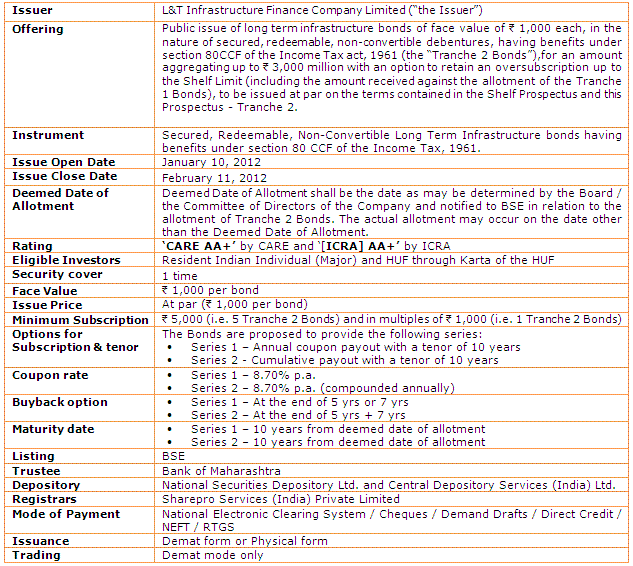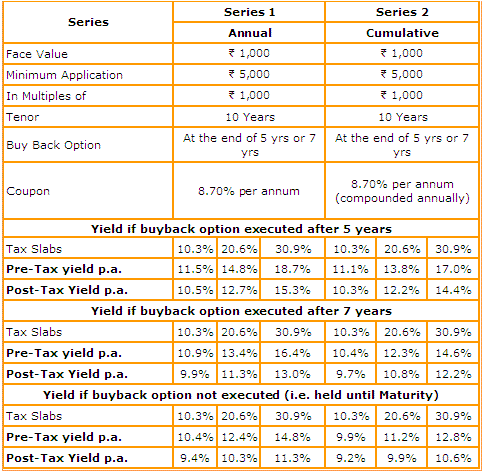In the Union Budget 2011-12, the Government retained the additional income tax benefit of  20,000 available under section 80CCF of the Income Tax Act, 1961 for investments made in long-term infrastructure bonds (as notified by the Central Government). This move is intended to provide a fillip to the infrastructure finance and provide an opportunity to individual tax payers to reduce their tax liability.
20,000 available under section 80CCF of the Income Tax Act, 1961 for investments made in long-term infrastructure bonds (as notified by the Central Government). This move is intended to provide a fillip to the infrastructure finance and provide an opportunity to individual tax payers to reduce their tax liability.
In light of the same L&T Infrastructure Finance Company Limited (L&T Infra) ("the issuer"), at present is offering "Tranche 2" of these long-term infrastructure bonds, which are available for subscription from January 10, 2012 until February 11, 2012. But before we assess whether Tranche 2 is really worthwhile investing, let’s understand the key highlights once again:
- What are these bonds named as?
These bonds are specifically named as "Long-term Infrastructure Bond".
- Who would be the issuers of these bonds?
The bonds will be issued by the following entities:
- Industrial Finance Corporation of India Ltd.
- Life Insurance Corporation of India
- Infrastructure Development Finance Company Limited
- A Non-Banking Finance Company (NBFC) classified as an Infrastructure Finance Company by the Reserve Bank of India (RBI)
- When will these bonds be issued?
These bonds will be issued in the financial year 2011-12 and the volume of issuance will be restricted to 25% of the incremental infrastructure investments made by the issuer during the fiscal year 2011-12.
- What is the minimum tenure of these bonds?
These bonds will carry a minimum tenure of 10 years.
- Is there a lock-in period while investing?
Yes, an investor is subject to a minimum lock-in period of 5 years while investing in these bonds.
- How does one exit after the lock-in period?
After the lock-in period, the investor may exit either through the secondary market or through a buyback facility, as specified by the issuer in the offer document at the time of issue.
- How would be the proceeds from these bonds used?
The proceeds from these bonds will be utilised for the purpose of infrastructure lending as defined by RBI (as per the guidelines issued by it).
- Is interest earned on these bonds taxable?
The interest received in these bonds is not tax free. The investor is liable to pay tax on the interest received.
The interest received on these bonds shall be treated as income from other sources and shall form part of the total income of the assessee in that financial year in which it is received. However no TDS shall be deducted on the interest received as these bonds if issued in Demat mode and listed stock exchange.
The details on the "long-term infrastructure bonds" offered by the issuer L&T Infra are as under:

Note:
1. PAN card is mandatory for subscribing to these bonds. A self attested copy shall be enclosed along with the application form.
2. Chq / DD should be drawn in favour of "L&T Infra Bonds 2012A". It should be crossed A/c payee only.
Investors’ will also have the following options available at the time of subscribing to the issue:

(Source: Application form of L&T Infra Long Term Infrastructure Bonds & PersonalFN Research)
Well, after reading the details of the scheme, there may be still some more questions popping up, which are attempted to answer herein:
- Can one invest in both the options?
Yes, one may invest in both the options. The bonds can be of the same series or bonds across different series.
- Can one apply in joint names?
Yes, one may apply in a joint name (with a maximum of three applicants). However, the demat accounts will also be required to be held in joint name and the order of applicant shall be the same as appearing in the demat account. Moreover, the tax benefit can be availed only by the first applicant.
- Who will get the interest in case of joint application?
In case of joint application, interest will be paid to the account of the first holder only.
- My demat account is in joint name, but I want to apply is a single name?
In case of a single application, demat account of the same single applicant would be necessary. Joint demat account would not do.
- What about the succession of the bond held in case of sole or joint holdings?
In case of joint holding of these bonds, if one of the joint holders expires, the survivor(s) will be recognised as bondholders. It will be sufficient for the issuer to delete the name of the deceased bondholder on obtaining satisfactory evidence of his death. Provided, a third person may call on the issuer to register his name as successor of the deceased bondholder after obtaining evidence such as probate of a will for the purpose of proving his title to the bonds.
In case of single or sole holding, the issuer will recognise the executors or administrator of the deceased bondholders, or the holder of the succession certificate or other legal representative as having title to the bonds only if such executor or administrator obtains and produces probate or letter of administration or is the holder of the succession certificate or other legal representation, as the case may be, from an appropriate court in India.
- Can a nominee be appointed?
Yes, a nominee can be appointed by sole holder / first holder or joint holders who, in the event of death of the sole holder or all the joint-holders (as the case may be), shall become entitled to the bond(s).
- Can one pledge or lien or hypothecate the bond, while obtaining a loan from a scheduled commercial bank?
Yes, one may pledge or lien or hypothecate the bond, while obtaining a loan from a scheduled commercial bank. However, this can be done once the said lock-in period is over.
TAXATION OF LONG-TERM INFRASTRUCTURE BONDS:
Your investment in these "long-term infrastructure bonds" will be eligible for a deduction under section 80CCF of the Income Tax Act, 1961 subject to a maximum limit of  20,000. This deduction limit of
20,000. This deduction limit of  20,000 will be over and above
20,000 will be over and above  1,00,000 benefit available under section 80C, 80CCC and 80CCD.
1,00,000 benefit available under section 80C, 80CCC and 80CCD.
However, the interest earned by you on the investments (in these bonds), will be taxed (by including the same as "Income from Other Sources", in the financial year in which it is received). However, since these bonds are issued in a demat as well as physical mode and listed on the exchange, no Tax Deduction at Source (TDS) will be done on the interest received under the demat mode.
OUR VIEW:
In our opinion investments in L&T Infra’s long-term infrastructure bonds, appears enticing from a tax planning perspective, as an investment upto  20,000 will be eligible for an additional (i.e. over and above
20,000 will be eligible for an additional (i.e. over and above  1,00,000 benefit limit available under section 80C, 80CCC and 80 CCD of the Income Tax Act, 1961) tax benefit.
1,00,000 benefit limit available under section 80C, 80CCC and 80 CCD of the Income Tax Act, 1961) tax benefit.
As regard the question which series to invest is concerned; the verdict would depend upon whether one wants to avail of the cumulative option or the annual coupon payout option. Hence, if one wants to avail of a cumulative option, then "Series 2 - buyback after 5 years" is recommended as better post-tax yields are offered. However, if one wants to avail of the annual coupon payout option, then "Series 1 - buyback after years" is recommended as it offers better post-tax yields.
It is noteworthy that opting for the longer tenor options would not be a prudent decision as they are offering lower post-tax yields.
Add Comments
| Comments |
vkvv35@yahoo.co.in
Jan 13, 2012
Senior Citizens may not find it attractive due to age factor. the lock-in period for such age category persons should have been a little less. |
karlk007@ya.ru
Jan 19, 2012
You're the one with the brains here. I'm watching for your posts. |
info@rancherolandcompany.com
Jan 19, 2012
Way to go on this essay, helped a ton. |
1